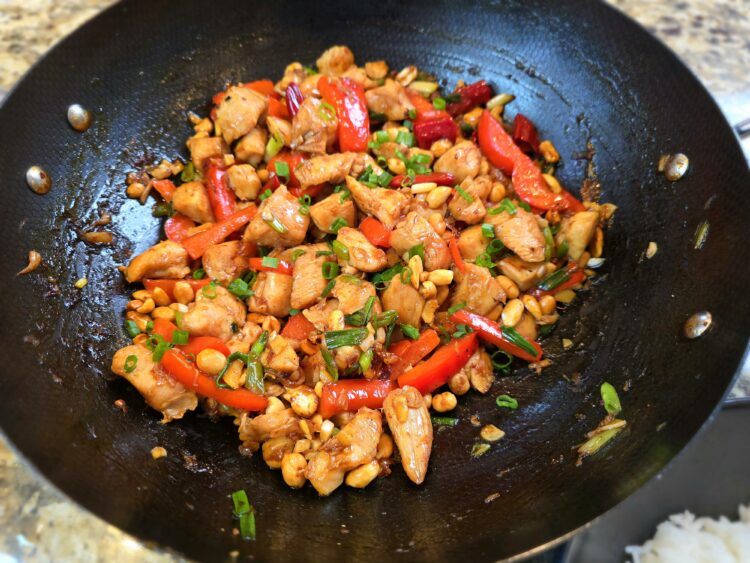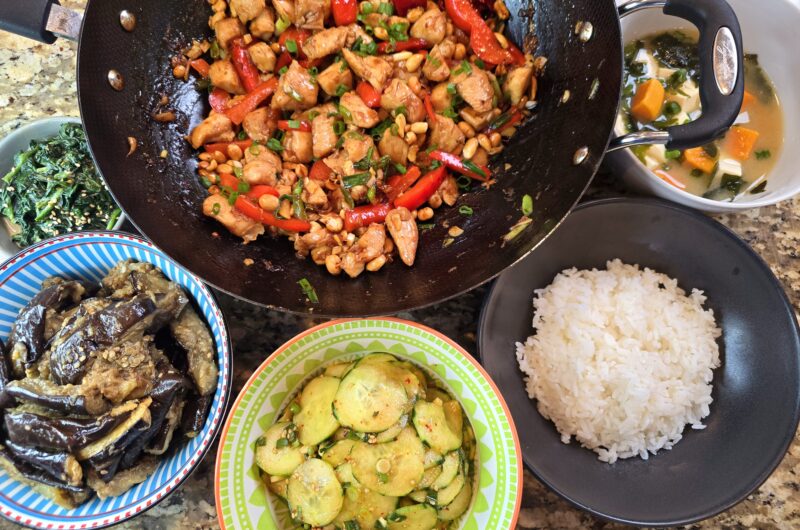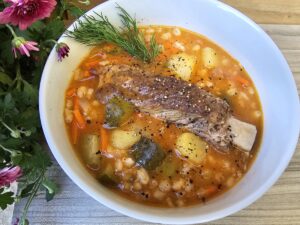Mastering stir-fry at home doesn’t require a wok burner or a professional kitchen—just a solid formula. This Stir-Fry Guide is built to be flexible, fast, and packed with flavor. Whether you’re using chicken, beef, tofu, or shrimp, this method teaches you how to marinate, sauce, and stir-fry with confidence.
The key is a two-part formula: a tenderizing marinade for your protein and a versatile stir-fry sauce that can be scaled depending on your vegetable mix. Everything from texture to flavor balance is thought through—so whether you’re making a simple chicken and broccoli stir-fry or loading it up with crunchy bell peppers, cashews, and aromatics, the result is deeply satisfying.
Why This Stir-Fry Formula Works:
- Simplified Velveting technique: A touch of baking soda and cornstarch in the marinade helps create tender, restaurant-style meat.
- Layered aromatics: Garlic, ginger, scallions, and dried chilies form the base of bold flavor.
- Scalable sauce: Adjust quantities easily based on how many vegetables you’re using, so nothing ends up dry or under-seasoned.
- Customizable heat and sweetness: Chili flakes, Sichuan peppercorns, oyster sauce, or hoisin can be added or swapped to match your preferences or pantry.
You can stir-fry in a wok or a large sauté pan—just make sure your pan is hot, ingredients are prepped, and you’re ready to move fast. This method walks you through marinating, pre-toasting nuts, managing vegetable batches, and deglazing the pan if needed.
Great stir-fry is about timing and flow. Cook firm veggies first, then proteins, then aromatics and sauce. Finish with a drizzle of sesame oil and a sprinkle of green scallions or toasted nuts.
Stir Fry Guide – Formula
4
servings15
minutes10
minutesIngredients
- Stir Fry Marinade (Per 1 lb meat):
1¼ tsp light soy sauce
¼ tsp dark soy sauce
1 tsp Shaoxing wine
½ tsp kosher salt
½ tsp sugar
½-1 tsp cornstarch (1/2 tsp for thighs or tender cuts, 1 tsp for breast/loin/flank)
¼–½ tsp baking soda (¼ tsp for thighs or tender cuts; ½ tsp for breast/loin/flank)
Pinch white pepper
1 tsp neutral oil (peanut, canola, or grapeseed — no sesame oil here)- Stir Fry Sauce (Per 1 lb meat/ plus 1- 1.5 cup veggies):
1 tbsp light soy sauce
2 tsp dark soy sauce
1 tbsp Shaoxing wine
2 tsp rice vinegar
2–3 tsp sugar (adjust if using hoisin; honey can also be used)
2 tsp cornstarch + 1 tbsp water (for thickening; add 30-60 seconds after the meat is sauced and cooked until thickened)
1 tsp sesame oil (drizzle over the stir-fry after removing from heat or just before serving)Optional additions to the Sauce:
1–2 tsp oyster sauce (adds savory, umami depth and glossiness, especially with beef, mushrooms, or broccoli)
1–2 tsp hoisin sauce (sweet, fragrant, more assertive; thicker and more complex than oyster sauce; ideal for dishes like kung pao, lettuce wraps, or tofu)Get creative! Increase the vinegar to 1 TBSP sometimes, change it to half balsamic vinegar or Chinkiang vinegar. Or try using honey instead of sugar.
- Stir Fry: Usual options:
3 tbsp neutral oil
4 garlic cloves, thinly sliced or pressed
1-inch piece of ginger, sliced, minced, or cut into matchsticks
6 scallions, white/pale green and green parts separated
½ cup roasted peanuts or other nuts
¼ - ½ tsp Hot red pepper flakes or dried red chiles, roughly chopped (6-12 of them)
Sichuan peppercorns (1/2 – 1 tsp)
6–8 dried Chinese chilies (such as árbol or Sichuan), halved with most seeds removed- Vegetable variations (select up to 1 to 1 1/2 cups):
1 small zucchini, cut into 1/2-inch dice
1 medium bell pepper, cut into 1/2-inch dice
1.5 cups broccoli or broccolini, cut into bite-sized florets
Onions, cut into segments
Cabbage (or a few cups of coleslaw mix)
Directions
- Place the meat in a medium bowl and add the marinade ingredients. Some cuts benefit from baking soda, but it can be skipped if desired. Stir aggressively with a utensil or your fingers. Marinate for 20-30 minutes. You can make this step in advance and keep in the refrigerator for a couple of hours.
- Prepare the rest of your ingredients: measure everything, chop the vegetables and garnishes, mix the stir fry sauce ingredients (leaving sesame oil out as you will drizzle it at the end) and mix the cornstarch slurry. Have your rice and serving bowls ready.
- Dry-toast your peanuts or cashews in the dry very hot wok before adding oil or starting your stir-fry—just 1–2 minutes over medium heat. Stir constantly until golden and fragrant. Remove and set aside, then begin your stir-fry as usual.
- Oil your wok with a thin layer of neutral oil. Heat the wok for a couple of minutes over high heat until steaming hot. Once hot, add a tablespoon of cooking oil.
- If using firm vegetables (e.g., peppers, onions), add them now and stir-fry for about 1 minute until tender-crisp. You may need to cook vegetables in 1-3 batches. Remove them to a plate and set aside.
- Wipe out the wok, if needed, and heat another 1-2 tbsp oil over high heat.
- Stir-fry the chicken. Add to the wok, let sear for 1 minute, then stir-fry for another 2-4 minutes depending on thickness. It should be mostly cooked. In most home kitchens, unless you have a high-BTU wok burner and your wok is perfectly seasoned, your wok may not be hot enough and some sticking may happen. If it does, use some Shaoxing wine or water to deglaze the pan and scrape up any bits that are stuck and threaten to burn.
- Now reduce to medium or medium-high:
When adding garlic, ginger, dried chilies, and Sichuan peppercorns (to avoid burning)
When cooking delicate ingredients like scallions, mushrooms, or leafy greens
When adding sauces (prevents caramelization or burning) - Make a well in the middle and add ginger, garlic, chiles stirring and cooking them for 5-10 seconds until aromatic, then toss everything well combining them with the veggies.
- Add white and pale green scallion parts and your pre-toasted (in step 1) nuts (e.g., peanuts) and cook for another 30 seconds.
- Return reserved veggies and toss to combine. Cook for 30 seconds or until chicken is mostly cooked through.
- Add your sauce and toss to coat. Stir in the cornstarch slurry gradually, using only what is needed to thicken the sauce. Adjust with more water if needed. Once the sauce is glossy and thickened and everything is cooked through, remove from heat. Stir in your sesame oil at this time.
- Garnish with green scallion tops or chopped nuts. Serve immediately over rice. Enjoy!
Notes
- Tips for Scaling the Sauce
Using more vegetables? Increase the stir-fry sauce as follows:
For 2 cups of vegetables, increase sauce by 50% (i.e., 1.5x the listed amounts).
For 3 cups or more, double the sauce.
This keeps everything flavorful and saucy enough without needing to rework the entire recipe.
If your sauce ends up too thick (from extra cornstarch), add 1–2 tbsp of water as needed to loosen it during the final stir.
General rule:
For every 1 cup of veggies added beyond the base 1 to 1½ cups, increase the sauce by about ½ batch (i.e., 1.5x or 2x total sauce depending on how much you add).











